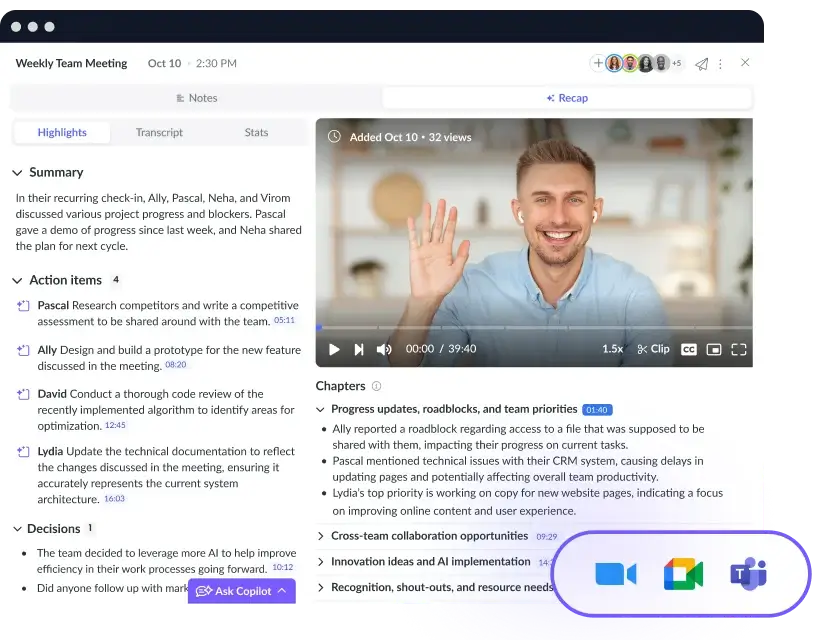Guide to Running Productive Engineering Team Meetings
Learn how to prepare for engineering team meetings and 6 tips for running productive engineering team meetings. Plus, get free templates!
Top-performing engineers are people who aren’t afraid to break out of their silo to innovate and experiment with new ideas. And they sure aren’t afraid of working in a fast-paced, agile environment either. Since engineers are inclined to put their ideas to the test quickly, they are more likely to run into blockers and they’ll be required to further experiment or go to their team for support.
This is where engineering team meetings and strong engineering leadership comes into play. Here we’re diving into the details of what you can expect from an engineering team meeting and how to get the most out of these meetings so your team can continue to innovate!
- What happens in engineering team meetings?
- How to prepare for engineering team meetings
- 6 tips for running productive engineering team meetings
- How Fellow runs engineering team meetings
- Free engineering team meeting agenda templates
What happens in engineering team meetings?
Engineering team meetings are when the full department gathers to discuss ongoing projects and processes. The idea is to align the team on the roadmap, create solutions to blockers, and receive organizational updates from management. Often, technical leads will start by sharing progress updates in their respective fields. Following, independent contributors may share demos on their areas of specialization. Since the engineering team can vary widely in skill set, experience, and areas of expertise, being able to see what’s going on in other segments of the department is helpful for knowledge sharing, team development, and process improvement.

Run productive engineering team meetings
Increase meeting engagement and productivity with a collaborative agenda that the whole team can contribute to. Try using a tool like Fellow!

How to prepare for engineering team meetings
- Create and share a meeting agenda
- Send out a meeting reminder
- Do a technology check (for remote meetings)
- Assign meeting roles
1Create and share a meeting agenda
Your meeting agenda is the underappreciated asset that will keep your discussions flowing at the right pace and on topic. For engineering team meetings, consider blocking out 10-20 minutes for announcements or updates that are related to the group and meeting purpose. Next, it might be ideal to have several technical leads take turns presenting progress on their projects and raising any challenges or blockers that might need to be addressed during the meeting. In between, you may choose to have time for brainstorming, problem-solving, or more progress presentations. Finally, close out with time for making decisions, assigning action items, and creating the plan for the next meeting date.
2Send out a meeting reminder
Just over a third of manager-level employees attend more than 16 meetings per week. That’s a lot of meetings to remember off the top of your head. Even with a calendar, it’s possible to forget an upcoming meeting or let one run a little overtime because you didn’t know there was another one following.
Luckily, with Fellow meeting reminders exist. Get a notification a day before to help you plan for any discussions in the call. Then on the day of, you can get notified within a few hours or minutes of the call, depending on your preference.
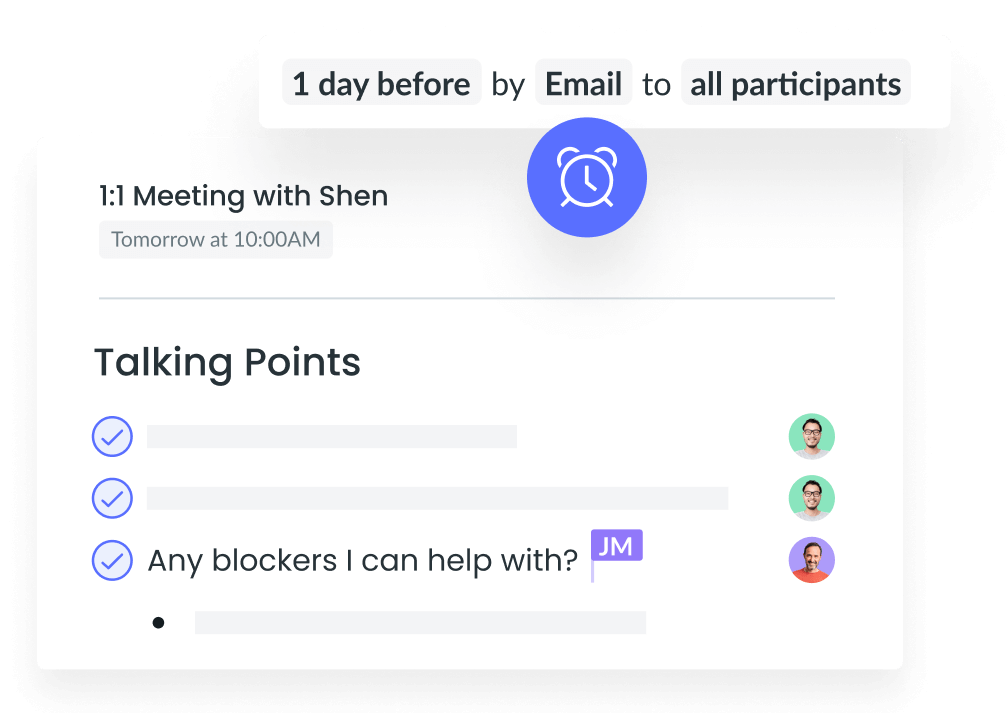
3Do a technology check (for remote meetings)
Technology checks are important for all meetings, but especially for remote meetings. Whether you’re meeting with a client or your internal team, all meeting time is valuable. Ensure you can make the most use of all your assigned meeting time by pre-checking things like your audio, visual devices (for example, built-in cameras, webcams, or presentation tools), connected tools (for example, mice, headsets, keyboards), and ensuring your Wi-Fi and VPN are connected. If you’re presenting in the meeting, also make sure that you’re comfortable opening and sharing your screen so you can dive into discussions right away.
4Assign meeting roles
Meeting roles drive value in a meeting as individual participants are assigned unique responsibilities to contribute to the meeting. All meetings will have an organizer or host, time-keeper, and note-taker. Additionally, engineering team meetings might have project leads (the main person or moderator who will lead the conversations) and product managers (who provide the voice of the customer or sales/marketing insights). Remaining attendees are optional, general attendees. Though, even general participants should still have some useful purpose for attending the call (for example, they need to be informed, they have relevant knowledge to contribute, or they are representing another stakeholder).
6 tips for running productive engineering team meetings
- Follow your agenda
- Allot time for demos
- Assign action items
- Encourage questions
- Give feedback on recent team projects
- Ask for meeting feedback
1Follow your agenda
Any engineering department likely has a long list of projects ongoing at any given time. In a meeting, it can be easy to get sidetracked and start discussing other projects that relate to the current conversation. However, if these side conversations aren’t part of your agenda, then you’re losing time that could be used for discussing the purpose of the meeting, and this loss of time might impact the team’s ability to assign action items or make decisions during the meeting. Having a time-keeper present in your meeting is a helpful way to nudge your team when the conversations begin to stray from your planned agenda.
2Allot time for demos
In many engineering teams, your colleagues are going to be working independently on projects in or around their specialized area of expertise. Allotting time for demos is a great way to help your team learn from each other by creating an opportunity to ask questions and showcase new areas of work. Additionally, this is a positive way to connect your team to solve blockers or provide feedback that can further improve the project.
3Assign action items
Meeting action items are the to-do’s following any meeting. Assigning these to meeting participants is a helpful way to make attendees feel included and to hold them accountable on those tasks in future meetings. When assigning action items, be clear if the requirement is flexible or if there is a specific structure or boundary tied to the action item. Also, determine if there’s a completion due date or required project review date. Giving the engineer as much information as possible will help them with their planning and completion of the task.

4Encourage questions
Great engineers are the first to ask questions because they’re curious to learn more about technical requirements and gain insights on how to better improve a product. When problem solving in meetings, ask engineers questions about the situation to get their wheels turning and empower them to find solutions to their own blockers. Probe deeper into things like:
- What is the deepest root cause of the problem?
- Why is this problem happening?
- Have we tried anything to fix this?
- What resources are still needed to fix this?
- How can the rest of the team support?
5Give feedback on recent team projects
Providing team feedback in a group setting is a great way to boost team morale and connection. To start, ask your team how they feel the project went. This will help gauge any differences in team member feelings, and may change how you perceive the feedback that you were aiming to share with the group. Sharing feedback in an open setting can allow for discussion on successes and challenges, as well as enable a conversation on how to better optimize processes for the next project. When building solutions together, the team will become more aligned.
6Ask for meeting feedback
Meeting feedback is important to help understand the value that your team is pulling from your meetings. While some team members may feel comfortable speaking out if something is wrong during a meeting, others may not be so comfortable. It also might be helpful to provide your team with an opportunity to reflect following a busy or information-packed meeting before sending out a meeting feedback survey. This reflection will enable your team to provide the best insights to improve your next meeting.
With Fellow, users can easily request meeting feedback to understand how their attendees felt about the meeting. Meeting feedback can be anonymous as well.
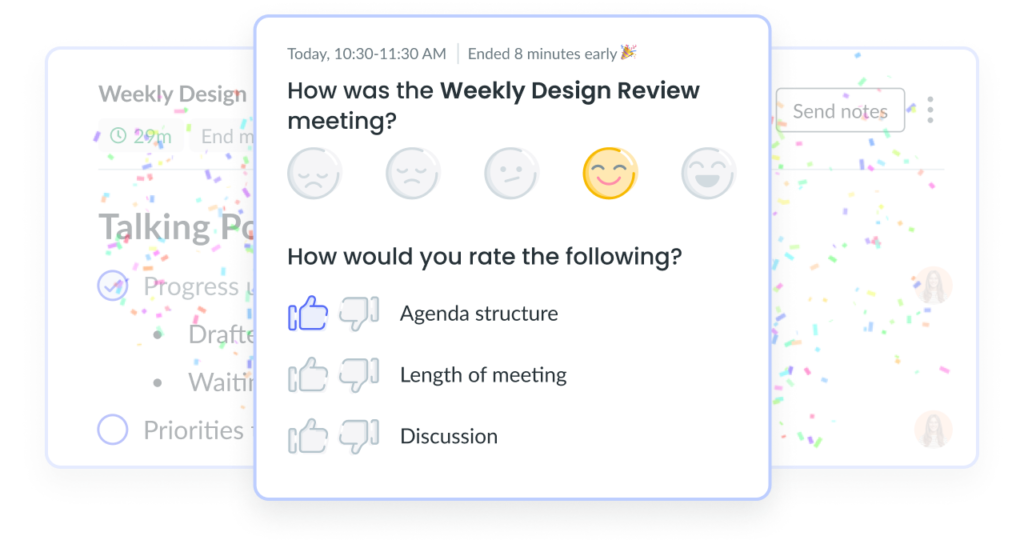
How Fellow runs engineering team meetings
Alexandra is the Engineering Team Manager here at Fellow and she provided some great advice on how she runs her engineering team meetings. Ahead of the meeting, she shares an agenda template with her team with four categories and free space for team members to write what’s on their mind. These four agenda items include:
- Small wins
- Demos
- Discussion topics
- Action items
Advice from Alexandra: “The day before the meeting, I use Fellow’s “Send Notes” feature to send the template to our #dev Slack channel. Everyone can see the note contents and can add talking points about demos they want to give, or updates and ideas for the team, all without having to leave Slack.”
When working in a hybrid team, Alexandra noted it’s especially helpful using digital tools that allow both in-person and remote team members to feel included. Fellow’s meeting management tool is just one example!
Post-meeting, Alexandra sends out a meeting feedback survey to her team. Over time, she says her meeting format and even the names of the agenda items have changed to reflect the latest team dynamic, which keeps everyone included and in sync.
Free engineering team meeting agenda templates
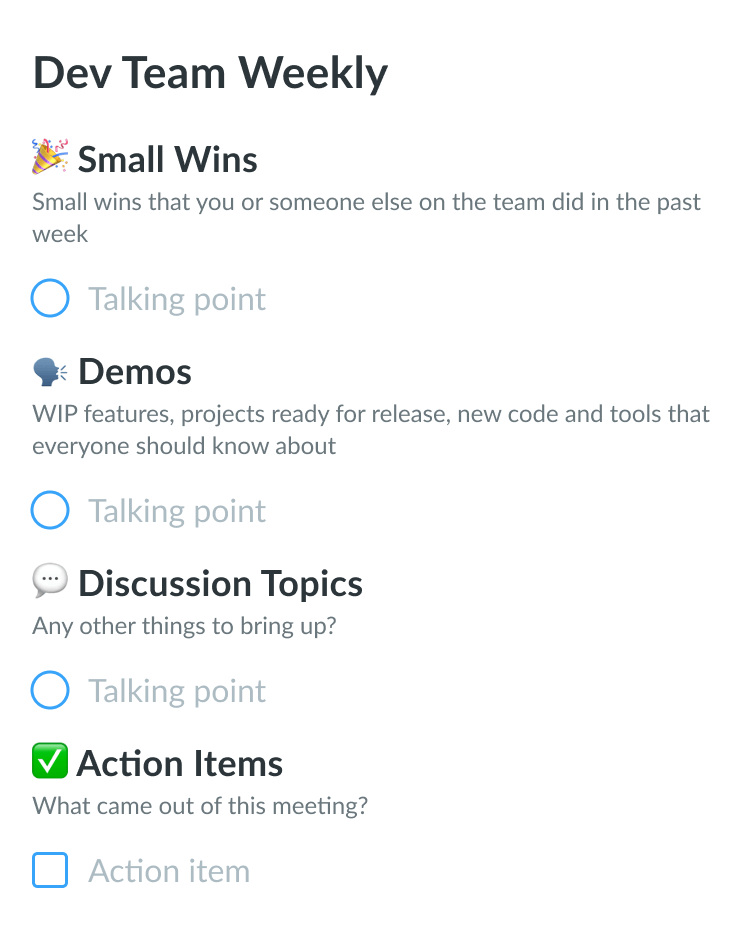
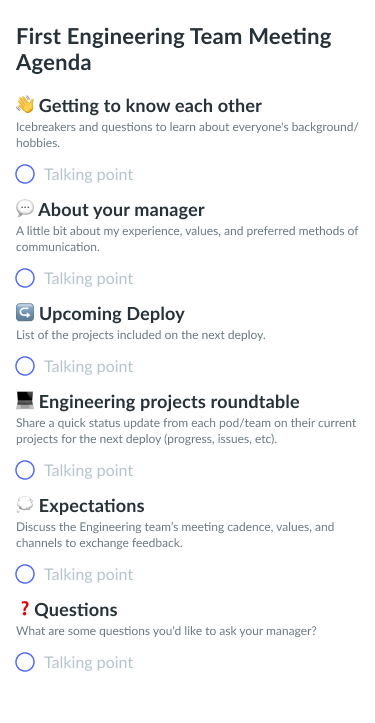
Parting advice
As your team grows, it can get harder to create team alignment. The most important part of building productive team meetings is building an engineering culture where team members can be inspired to question, innovate, challenge the status quo, and collaborate with others. Through this, your team can maximize their knowledge sharing and solve blockers faster than ever!
